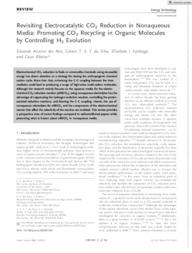Revisiting Electrocatalytic CO2 Reduction in Nonaqueous Media: Promoting CO2 Recycling in Organic Molecules by Controlling H2 Evolution.
Revisiting Electrocatalytic CO2 Reduction in Nonaqueous Media: Promoting CO2 Recycling in Organic Molecules by Controlling H2 Evolution.
Author(s): REIS, E. A. dos; SILVA, G. T. S. T. da; SANTIAGO, E. I.; RIBEIRO, C.
Summary: Electrochemical CO2 reduction to fuels or commodity chemicals using renewable energy has drawn attention as a strategy for closing the anthropogenic chemical carbon cycle. More than that, enhancing the C?C coupling between the intermediates could lead to producing a range of high-value multi-carbon molecules. Although the research mainly focuses on the aqueous media for the electrochemical CO2 reduction reaction (eRRCO2), using nonaqueous electrolytes has the advantage of suppressing the hydrogen evolution reaction, controlling the protonassisted reduction reactions, and favoring the C?C coupling. Herein, the use of nonaqueous electrolytes for eRRCO2 and the components of the electrochemical reactor that affect the selectivity of the reaction are revisited. This review provides a perspective view of recent findings compared to well-established papers while presenting what is known about eRRCO2 in nonaqueous media.
Publication year: 2023
Types of publication: Journal article
Unit: Embrapa Instrumentation
Observation
Some of Embrapa's publications are published as ePub files. To read them, use or download one of the following free software options to your computer or mobile device. Android: Google Play Books; IOS: iBooks; Windows and Linux: Calibre.
Access other publications
Access the Agricultural Research Database (BDPA) to consult Embrapa's full library collection and records.
Visit Embrapa Bookstore to purchase books and other publications sold by Embrapa.

